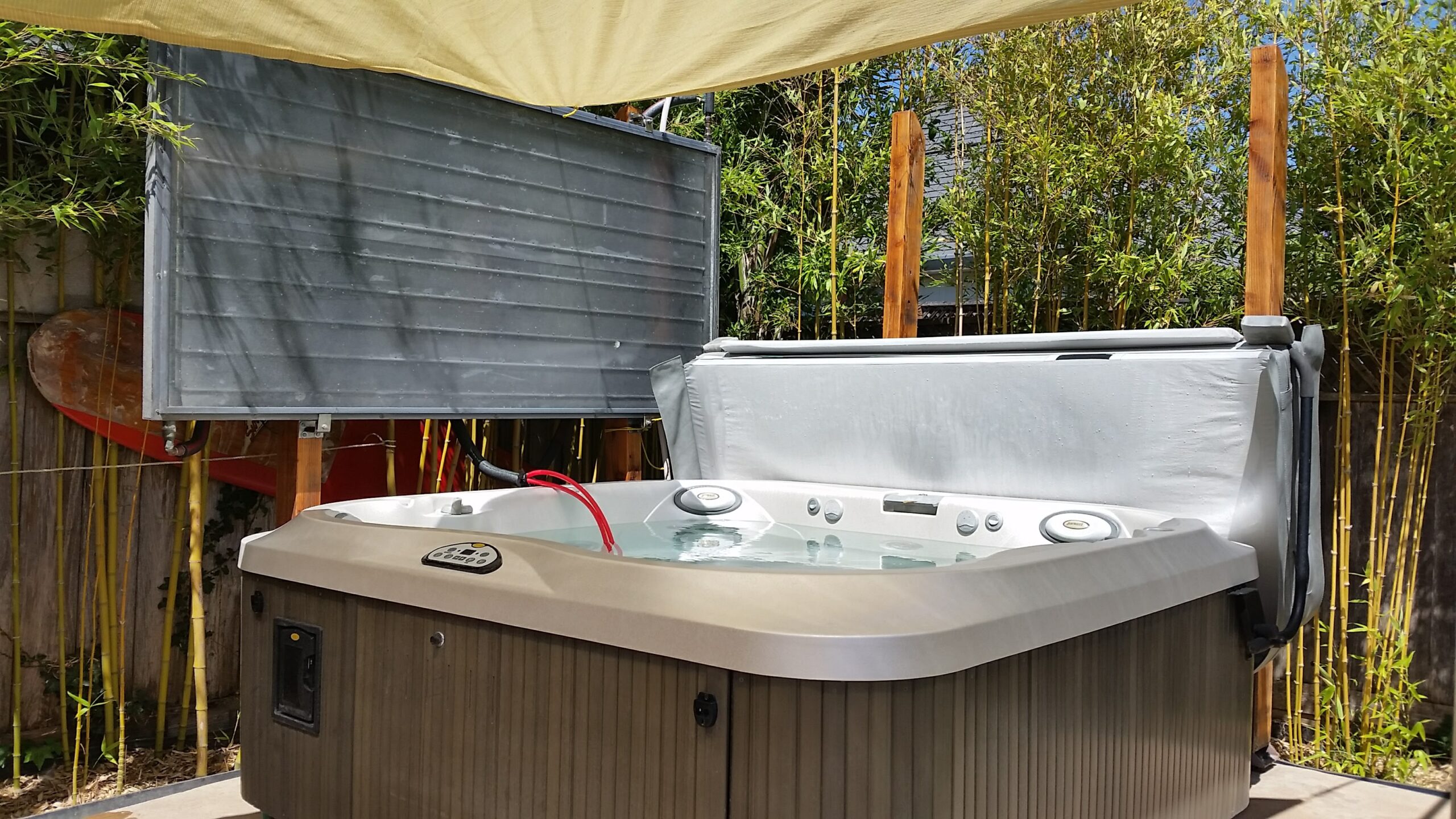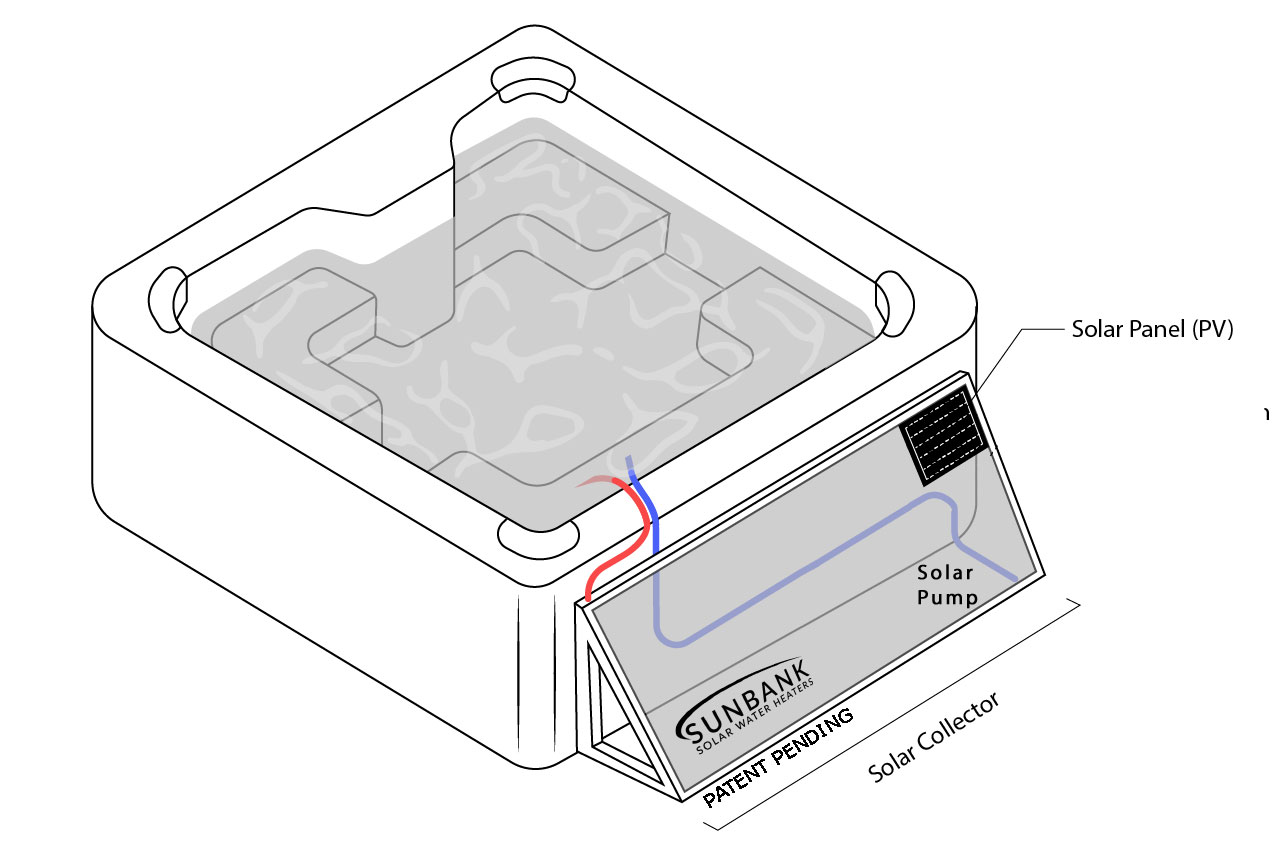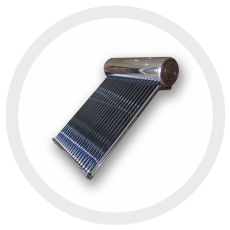How the Solar Hot Tub Kit Works
The Sunbank Solar Hot Tub Kit is the least expensive way to heat a hot tub, but how does it work?
It’s pretty simple, really. The Sunbank flat plate collector traps the heat from the sun, and copper pipes running through the collector allow the hot tub water to circulate through the collector, via a solar powered pump, transferring that heat into the tub. And just like that, you’re heating your hot tub with the sun instead of fossil fuels.
How It Works
The solar kit can be added to any hot tub, but it’s good to know how it works and what to expect.
The solar hot tub kit will start heating the tub in the morning, raising the temperature above your electric or gas thermostat setpoint during the day. Without the solar hot tub kit, the tub’s thermostat would kick on multiple times an hour to keep the tub at temp, but with the kit, on a sunny day, the backup heater will stay off. This is how you save energy. Depending on the weather, the volume of the tub, how well insulated it is, how many collectors you have installed, etc., the tub may heat from a 102F setpoint (for example) up to 104F, 108F or higher during the day. This is all free energy. If you don’t use the tub that day, the tub will slowly cool down after sunset back to 102F and will be back on electricity for the evening. If you decide to have a sunset soak, you can easily dissipate any excess heat by turning on the jets. With the insulated cover removed, spa jets can dissipate heat at up to one degree per minute with no heating element turned on.
Some people who are either off-grid or want to run their spa completely from solar, will need to install two or more collectors depending on the size of their hot tub, the local climate, etc. Using the system like this works well for sunset soaks, as the system is typically at it’s hottest at the end of the day, cools overnight, and heats again the next day. Using the solar hot tub kit like this means, of course, that you will only have a hot tub on sunny days.
Mounting Options
The preferred mounting option is to mount the collector(s) at a 30-45 degree tilt adjacent to, but just above the hot tub. We’ll refer to this as the “drain back option,” as this allows the hot tub water to drain back into the tub when the pump turns off. The collector can be mounted on a platform specifically built for this purpose, a pergola type structure, or even a nearby roof. If the top of the collector is more than 9 feet above the water line, you will need a second pump mounted in series to increase the head height. Mounting the collector above the hot tub and allowing it to drain back provides freeze protection at night. This drain back feature can also provide overheat protection. For example, if you set your electric thermostat to 102F and only want the solar to heat the tub to 106F, you could install our solar controller to turn the pump on and off based on the temperature of the tub. This option requires the installation of a temperature sensor, requires AC power to run the controller, and adds unnecessary complexity for most installations. But it may be right for some applications.
You can also mount the collector using our Vertical or Horizontal Mounting Bracket at the same level as the hot tub, with the collector below the water line. This is only recommended in climates that don’t have prolonged hard freezes that are capable of freezing an outdoor copper pipe, or for customers who use their system seasonally. In this configuration, the collector is below the water line and therefore stays full of water. With this option, the pump should be powered by a solar panel (provided in the kit) so that the water in the collector does not overheat. It is possible to achieve thermosiphon circulation with this mounting option, but using the pump is recommended.


Plumbing Integration
Our redesigned kit runs the hot water directly through the collector. There is no problem running chlorinated water through a copper pipe. In fact, copper has a disinfecting property and could allow you to use slightly less chlorine while keeping your water clear. There are two options for how you will get your hot tub water into the collector(s).
The first option is to integrate with the hot tub’s plumbing. Hot tubs typically have PVC plumbing, and you will cut a section of this piping out and add in two tees, a supply and return to the collector. The pump will be mounted here, inside of the hot tub housing, where it is dry and safe from freezing. If mounted outdoors, the pump will need to be housed in a weatherproof box. The pump will turn on either when sun hits the solar panel mounted next to the collector, or when the controller turns it on, according to your settings. Hot tub piping varies, and so these pipe and fittings are not provided in the kit. Check with your spa manufacturer if you are concerned about voiding your warranty.
The second option, is to run the pipe or hoses from the collector directly into the hot tub water. In this scenario, the pump will be mounted in a weatherproof box. Make sure that the supply pipe/hose always stays below the water line in the hot tub, so that the pump can always draw water. And for those with freezing concerns, you will want to follow solar thermal installation best practices, one of which is to be sure that the lines are sloped to drain and have no places where water can accumulate and freeze.
Sizing
How many collectors you can use depends on a number of factors, including: how much space you have for collectors, your local climate, collector shading, how well insulated your tub is, the size of your tub, how often you use your tub, whether or not you use jets (they quickly dissipate heat), etc. There are two methods to see how big of a system you need.
- If you can isolate the energy use from your spa or hot tub heater, either by looking at your utility bill (which is difficult unless it is the only appliance that uses gas, for example) or by metering the electricity consumption.
- Heat your hot tub up to temp and then turn off the heater. Open the cover and turn on the jets for the amount of time that you would normally use the tub. After 24 hours, measure the temperature of the tub. If you know the temperature difference and the volume of the tub then you know how much heat input it requires in a day. This is not as precise as metering, but is a close approximation.
If you have a functioning tub, it’s probably best to start with one collector. You can always add more later. If you are using solar as your only heat source, you should start with at least two collectors.
Placement
If your hot tub is located in a place that gets a lot of sunlight then you can mount your solar hot tub kit directly adjacent to the hot tub. Not everyone will be able to mount the solar collector right next to the hot tub. You might want to mount the collector on your roof, a nearby fence, or the pergola over the hot tub. Let us know your mounting location, and we may be able to help you get the correct mounting hardware.
In Summary
The hot tub kit may be a good fit for you if:
- You want to use less electricity or gas to heat your hot tub.
- You feel like you have a good understanding of how the system works and are confident doing basic plumbing work.
- You have a good location to mount the collector(s).
- You are fine with slightly overheating your tub in order to save energy.
- You understand how to properly freeze protect your system, if necessary in your climate.
Give us a call!
(888) 385 0005
2020 5th St #1713
Davis, CA 95616
©2011-2024 Sunbank Solar, Inc.
All Rights Reserved

Sunbank SB-80G
80 Gallon Solar Water Heater $3,999 ($2,799 after tax credit)
